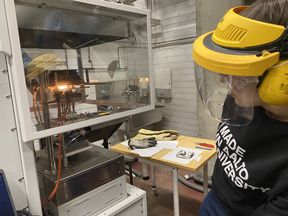BIOSUOJA project is saving lives by developing bio-based fire retardant coatings

You may not think of wood first when looking for a material to slow down the spread and extent of fire, but that doesn’t stop the BIOSUOJA project. Master’s students Veera Ollikainen and Saleh Khan are new on the job in the past year, but they already have a proof-of-concept coating that beats the current commercially available products used in interiors like airplanes, offices and schools. With the leadership of postdoctoral researcher Ahsan Uddin, these students have moved incredibly quickly in developing the chemistry, balancing industry safety requirements and sustainability, and implementing the prototype coating in lab tests.
Khan says, “The secret lies in the chemical modification of the prototype’s lignin and cellulose combined with bio-based additives to introduce fire-retardance and other properties that promote the so-called intumescent process. Such a coating is one of the most efficient ways to protect materials against fire.” Ollikainen adds, “Intumescence is a mechanism whereby the fire retardant swells and forms an insulating char that is porous and efficiently protective when exposed to heat.” She explains their innovative process: “The best ideas are often born semi-accidentally, and so it was in our case. When burning some samples, we noticed that one of our formulations was highly intumescent, so we decided to continue investigating it.” Uddin emphasizes the scientific novelty of Ollikainen’s and Khan’s work: “With the findings of our students, we have gained a clearer understanding of the thermal stability requirements of the fire-retardant systems’ raw materials, also in general. We will definitely publish these results together in our upcoming articles,” he adds.
Juha LipponenI immediately told my team that they just saved lives in the future. What can be a more rewarding research outcome?
Supervising professor Juha Lipponen acknowledges that while the research is still in its early stages, importantly, the young researchers are poised to save lives in the future. Given that current fire-retardant coatings can withstand catching fire for 75 seconds on average in lab testing, the Aalto group noticed that their best tested biomaterials can withstand ignition for several minutes. Industrial project partners have already found the preliminary results very interesting. “Even seconds matter when people need to evacuate from a burning building or an airplane. Here, our team could delay the ignition for minutes. I immediately told my team that they just saved lives in the future. What can be a more rewarding research outcome?”, Juha Lipponen excitedly explains.
In her own trials, researcher Dr. Irina Turku of XAMK, the project’s research collaborating partner, also observed results that support the Aalto team’s findings. “Nature has developed unique mechanisms that enable trees and plants to withstand various challenging conditions, including the risk of fire. By studying, adopting and further improving these natural mechanisms and materials, we can establish a safe and sustainable environment for our daily lives”, Turku says.
Let’s recall that the coating is made from wood and plants. Biomaterials are not always recognized for their full potential, despite billions of years of evolution: “When biomaterials or non-toxic materials are proposed to replace more harmful or fossil counterparts, people often presume that using safer materials requires some kind of compromise in their performance. In our tests, however, some of our biomaterials showed far superior performance compared to the traditional coating,” Lipponen concludes.
In addition to giving people more time to evacuate, the Aalto team’s developments also benefit anyone exposed to the chemicals, such as people working with those fire-retardant coatings. Today’s commercially available fire retardants often use ingredients that are suspected to be harmful. The BIOSUOJA project proposes a bio-based and safe raw material for fire protection coating.
The BIOSUOJA project is conducted in cooperation with the South-Eastern Finland University of Applied Sciences (XAMK), as well as multiple company collaborators (Carbon Reuse Finland Oy, Andritz Oy, Aisti Corporation Oy, European Cellulose Insulation Association, Kumart Oy, Nordic Bioproducts Group Oy, Tikkurila Oyj/PPG Finland Oy, the City of Savonlinna). The European Regional Development Fund project is co-funded by the European Union.




Read more news

Deepika Yadav leverages technology to improve women's health
Deepika Yadav recently began as an assistant professor at the Department of Computer Science in the field of human-computer interaction (HCI) and interaction design for health and wellbeing.
Study: Internal combustion engine can achieve zero-emission combustion and double efficiency
A new combustion concept that utilizes argon could completely eliminate nitrogen oxide emissions from internal combustion engines and double their efficiency compared to diesel engines.






